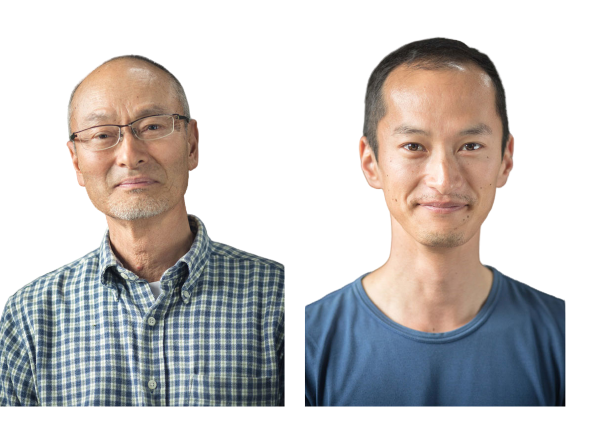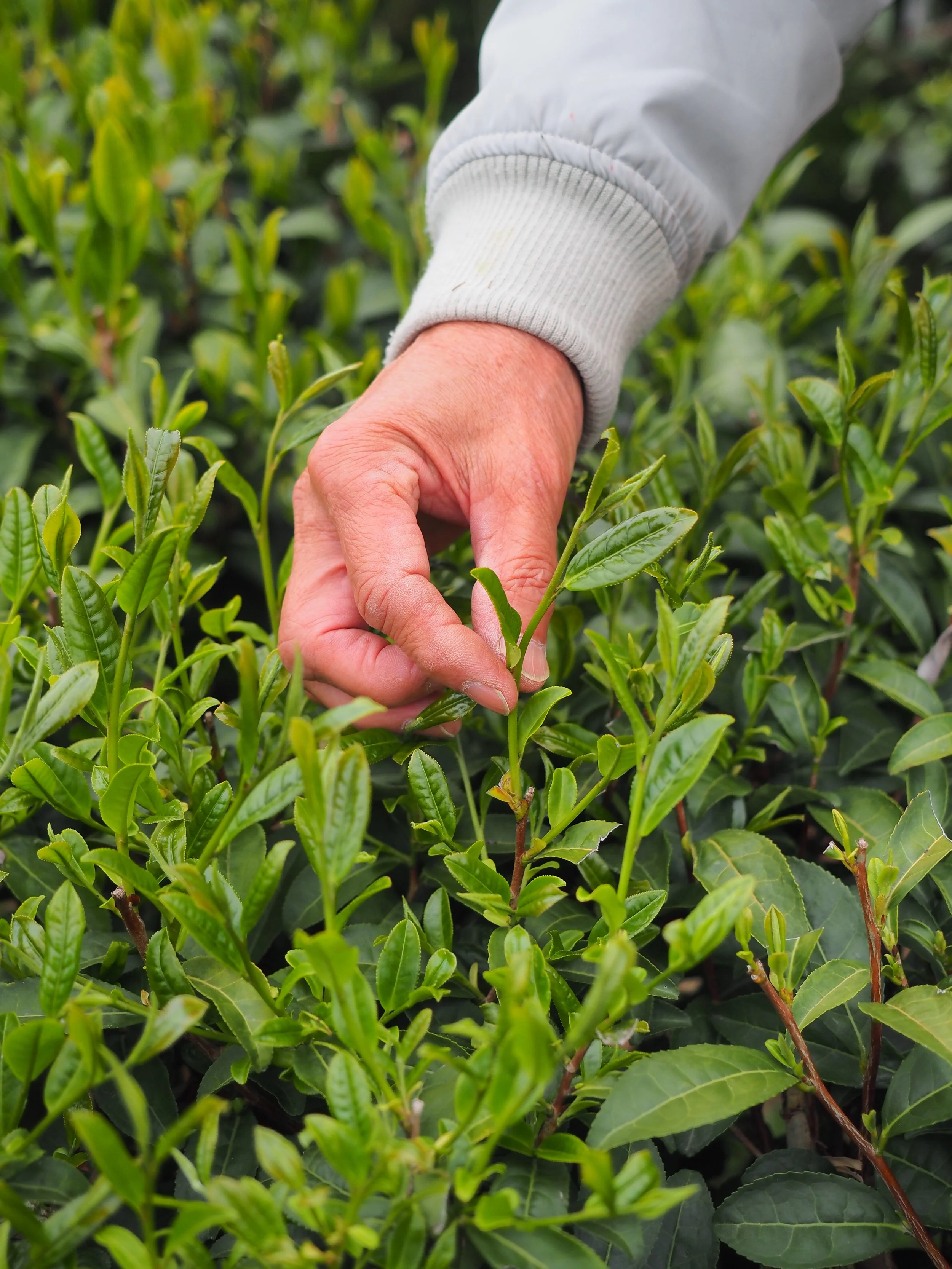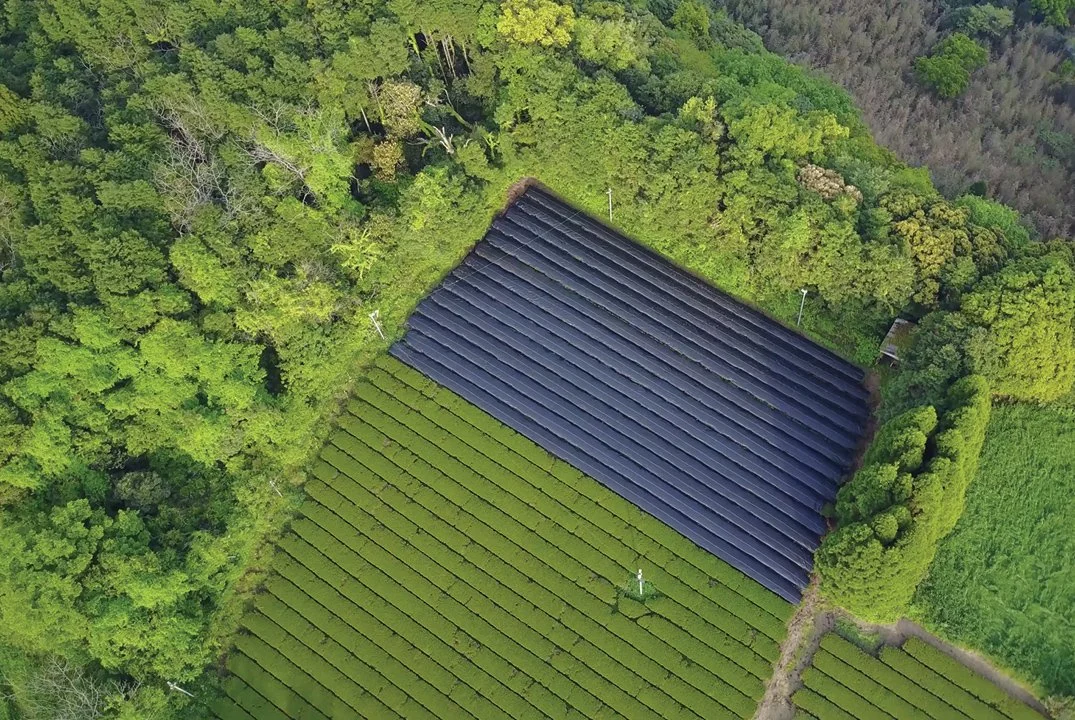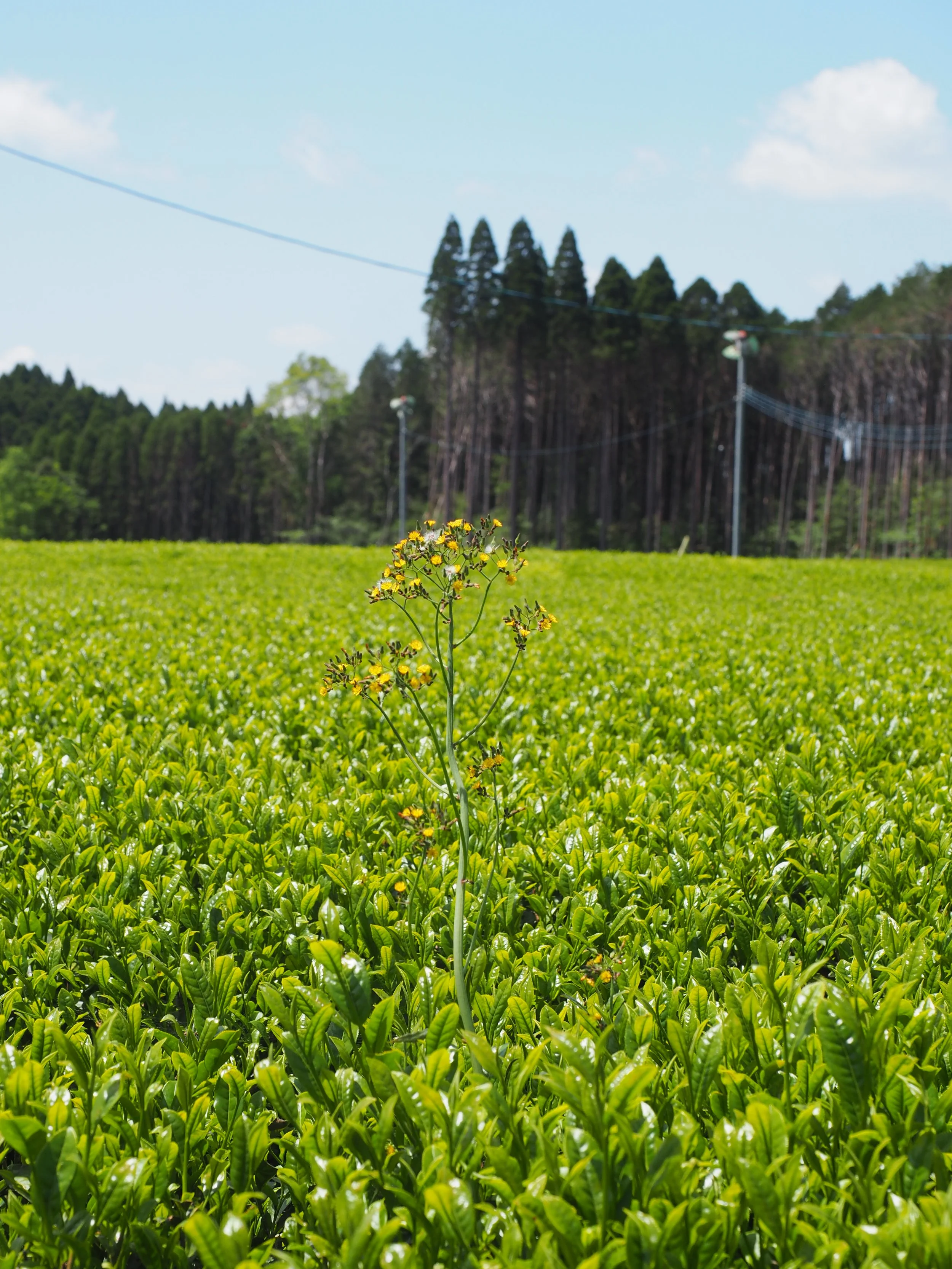From the Fields: Life as a Fifth-Generation Tea Farmer
Osamu Hayashi standing among his prized tea plants.
High atop a plateau in the volcanically active Kirishima Mountains sit the organic tea fields of Osamu Hayashi and his family.
Since 1897, successive generations of the Hayashi family have managed these fields and pioneered the art of organic tea cultivation. By eschewing chemical fertilizers and pesticides, producers like the Hayashis accept smaller yields in return for unparalleled quality.
Osamu Hayashi kindly agreed to speak with us about life on his family’s farm.
Osamu Hayashi and his son, Shutaro.
To learn more about what it take to create the highest-quality Japanese tea, we sat down to talk with Osamu Hayashi, whose son Shutaro - the fifth generation of the family to work this same plot of land - currently leads the family farm that produces Morihata Organic Tea.
Read on for Hayashi-sensei’s personal account of his farm’s humble beginnings, consumers’ changing tastes and the importance of traditional organic farming in a modern world.
This interview was translated from Japanese and lightly edited for clarity.
If your web browser has an automatic translation feature, we recommend turning it off while reading this article.
普段お茶を飲んでいない方、日本茶について知らない方へ、または、霧島のお茶のアピール等をお願いします。
For people who are unfamiliar with Kirishima tea, can you give us a brief introduction?
鹿児島県は静岡に次ぐ、日本第2位の生産量を有しています。
静岡県が機械化が困難なうえ、加えて高齢化で栽培面積が減る中、鹿児島県は順調に面積を拡大しています。
霧島はご存知の通り中山間地に位置している関係で、早場所の南薩よりは生産時期が遅くなりますが冷涼で霧等の茶の生育環境には良好な土地柄と思います。
南薩の深蒸しと比べると霧島のお茶は普通蒸しから浅蒸しです。
深蒸しは色が濃く綺麗にでますが、浅蒸しの方が品種の特性(味、香り)が良くでますし、私個人的には好きです。
Kagoshima Prefecture is the second largest tea-producing region in Japan after Shizuoka. However, while production in Shizuoka Prefecture is shrinking, production in Kagoshima Prefecture is steadily expanding.
As you might know, Kirishima is located in a mountainous area. The climate here is cool, foggy, and misty and is perfect for growing tea. There are regions in the south that are quicker to harvest (like Nansatsu), but the growing conditions are much better here. Those regions get more sun and result in a thicker tea leaf. That is why deep steaming (fukamushi) is often used in Nansatsu. Deep steaming creates a darker color, but light steaming (asamushi) produces a better flavor and aroma, and I personally like it better.
The Hayashi tea fields covered in mist.
どのようにお茶にかかわるお仕事を始められましたか?
How did you start in the tea business?
私の曽於祖父が東京へタバコの商売へ出かけた折、静岡のお茶を見てお茶の栽培、製造を始めたと聞いております。
私の息子達で5代目となります。
勿論、私は曽於祖父は知りませんが祖父は趣味人でハンティングや琵琶や尺八、囲碁を嗜む人だったようです。
私の父は真面目一辺倒の仕事人間で兵役後、茶園を引き継ぎ茶園面積の拡大と茶園管理作業機(乗用型摘採機)の開発に力を注いでいました。
今のバリカン式の茶刈機は父の発案で、私の尊敬する自慢の父です。
ご先祖のおかげさまで、今の私達の暮らしがあります。
The Japanese tea harvesting machine developed by Osamu's father.
When my great-grandfather went to Tokyo to go into the tobacco business, he also learned about tea growing in Shizuoka. He took what he learned and started to grow and produce tea.
Today, my son is a fifth-generation tea grower and continues our family’s heritage.
I did not know my great-grandfather, but I’ve been told that he was a serious and hardworking man who liked to hunt, play the biwa and shakuhachi (traditional Japanese instruments), and play Go.
After serving in the Army, my father focused his life on tea and developing a special tea-harvesting machine that is still in use today. I am proud of my ancestors; because of them, we are fortunate to have our fulfilling lives today.
お茶に関わるお仕事を始められてどのくらいになりますか?
How long have you been producing tea?
私は24歳の時に鹿児島に帰り家業を継ぎ現在に至りますが、すでに本業はリタイヤして息子二人に全てを任せている次第で、足掛け46年ぐらいになります。
長男は12年、次男は6年の実務経験です。
I returned to Kagoshima and took over my family business at the age of 24. I worked for 46 years and retired from the main business and left it to my two sons.
My eldest son has been working for 12 years, and my second son has been working for 6 years so far.
霧島製茶さんのお茶の特徴をお聞かせください。
What are some of the unique characteristics of your teas?
「植物は自分で自分の世話をする」といいますか余り手をかけない方が本来の姿かと考えております。
草の目立つ茶園ですが見た目はともかくとして「茶葉(製品)に入らないように」というような考えでやっております。
因みに、物理性、微生物環境性から草は生えていた方が良いと私は考えております。
製造においては「品種の特性がでるような製造を」と、やって参りました。
単品(品種ごと)で販売するのもそのためです。
We often say, “Plants take care of themselves.” If you don’t interfere with their natural growth, their true flavor can develop. We are diligent about removing weeds but think it's best not to remove all weeds to help improve the microbial environment of the soil.
We strive to bring out the characteristics of each individual tea. That is why we do not mix or blend our teas and instead sell each one on its own.
鹿児島(霧島)でお茶を栽培する特別な意味や効果についてお聞かせください。
What is special about tea grown in Kagoshima?
茶に限らず植物も動物もそうですが四季折々の寒さが、暑さが、風が、雨が必要と思います、霧島はその点茶には恵まれた土地柄かと思います。
特段、霧島でなくともその土地柄のお茶の特徴はあると思います。
I think all plants and animals require the cold, the heat, the wind, and the rain of the season to grow. Kirishima has all of these things and has a well-deserved reputation for tea production. Each tea grown here has the unique flavor of its origin.
お茶のお仕事に長年されていると思いますが、お茶市場のトレンド(傾向)などお気づきになられた点についてお聞かせください。
What are some trends that you have seen in the tea market since you started?
最近は色(水色、色択)を過度に重視しているように思います。
昔の「茶業全書」をみると水色は「やまぶきいろ」が良いとありました。
トレンド、流行でしょうが茶市場での入札でも外見、水色が重視されています。
もちろんそれらの物は欠点はないでしょうが滋味を見るまもなく次々と忙しく外見重視、色重視の入札が現状です。
私が若い頃、小さな茶工場を訪れた際出されたお茶はお世辞にも綺麗な緑ではありませんでしたが、今もってその味は忘れることができません。
だからこそ勧めてくださったのだと思いました。
Lately, the biggest trend is color. According to the old tea industry book, the color of good tea should be “Yamabuki iro” (or golden yellow). Unfortunately, the color of tea is now more important than flavor when bidding takes place at the market.
When I was younger, I visited a small tea farm and was served a cup of tea. I remember that the color of the brewed tea was not very good, but I could not forget the amazing flavor. I learned then that good-looking tea is not always good-tasting tea.
A section of this field is covered to shade the plants from the sun, a common practice in Japanese tea cultivation.
お茶の製造過程において消費者が知らないと思われることありましたらお聞かせください。
What are some things consumers might not know about tea production?
インターネットで皆様ご覧になっていると思いますので、ご存じないこともないとは思いますが。
茶葉の摘採時期について一言申し上げれば、物事適期があるように早摘みすれば外見は綺麗ですが味は淡白、薄いです。
しかしながら、過ぎれば渋みが強まります。
概して野菜も甘いのが好まれますがお茶に関しては甘み、渋み、苦味もバランスよく適度に必要です。
さらに香りです。
嗜好品ですので一概に値段の高いお茶が良いとは限らず、渋みを好まれるお客様もいらっしゃいます。
最近はお茶の機能性が話題に上るようになり、メチルカカテキンを沢山含有する「べにふうき」の緑茶の問い合わせが多くなりました。
これは渋みが幾分強く、味ではなく機能性を求めての事と存じます。
さらに、霧島製茶では「緑茶微粒ペースト」を販売していますが加熱に強いのででお菓子屋さんからの注文が多くなりました。
Nowadays, people can use the Internet, so they already know many things, but they may not know that the timing of plucking the leaves is very important.
If you pick early, the leaves look fresh and beautiful, but the taste is light and weak. If we wait, shibumi (astringency or bitterness) gets stronger. Most people like their vegetables to be a little sweet, but with regards to tea, sweetness, bitterness, and astringency should be balanced. Expensive tea is not always good tea, and some customers prefer a more astringent taste.
Recently, the functionality of tea has become a topic of interest, and orders for Benifuuki green tea (which contains a large amount of methyl catechin) have been increasing. Benifuuki tastes very bitter, and because of that, it is very popular for its functional health benefits.
Osamu Hayashi reviews the growth of a tea plant on his farm.
ある1日の作業工程をお聞かせください。
What does your typical day involve?
因みに、今日2019.4.23の作業日誌。
「東在来種」の株元除草を4名で作業。
畝間は息子が数日前に刈払い機で除草済み、株元を手でとりました。
「べにふうき」の畝間除草を息子(次男)が刈払い機にて作業。
長男は工場掃除、整備。
私は除草機械の整備。
以上が今日の作業内容です。
後数日で2019年一番茶が始まりますので猫の手も借りたいほどの忙しさです。
From my diary dated 4/23/2019:
With four people, we removed a native species of weed.
My son completed weeding with a mowing machine, and we picked the roots in the furrow by hand.
My other son weeded in the Benifuuki field with a mowing machine.
My eldest son cleaned the factory and maintained the facility.
I maintained our mowing machine.
In a few days, harvesting of the “first flush tea” (ichiban cha) of 2019 will begin. We will be very busy and short-handed.
お仕事の中で特に大変なこととはどのようなことでしょうか?
What is your biggest challenge?
仕事の段取りでしょう。
天気、作業員の日程などこちらサイドでどうにもできないことがあります。
「草は生えていた方が良い」と申しましたが、これも程度問題で後手に廻ると茶園が見えなくなることもありますし、農業は日数管理どおりにはいかないのが難しいところでしょうか。
The most difficult and important work is arranging schedules. We cannot control the weather and the schedule of the workers. If we postpone weeding, they will grow so quickly that you wouldn’t be able to see the tea field.
Farming does not always go according to day management. It is difficult.
将来、世界に向けての日本茶の展望をお聞かせください。(どういう感じになっていくでしょうか?)
What do you see for the future of Japanese green tea in the world?
今、日本ブーム?で日本文化、日本食が世界で注目されていると思われます。
今まではお茶といえば茶道のお点前、抹茶のことでしたが、これからは煎茶を含めた日本茶全般が認識されると思っております。
息子達もヨーロッパへの行商においてもその手ごたえを感じているようです。
お茶そのものの販売もそうですが淹れ方、飲み方のシチュエーション、また茶器を含めた文化的なものもお伝えしていく必要があるように思います。
These days, it seems that Japanese food and culture are popular around the world.
Until recently, when speaking of tea, it was all about matcha and the tea ceremony, but now I think general Japanese tea, like sencha, is becoming more recognized.
My sons went to Europe and felt that many more people were drinking Japanese green tea. I feel it is our responsibility to share with people how to prepare and enjoy tea, and to teach them about teaware and Japanese tea culture.
Shutaro Hayashi shows fresh-picked tea leaves.
番人気の商品は何でしょうか?
What is your most popular tea?
難しい質問ですね。
私の家でいうと長男は「あさつゆ」「あさのか」が好きで、「あさのか」面積を増やしています、次男は「焙じ茶」が好き、私は「かなやみどり」が好きとそれぞれです。
海外では「あさつゆ」が人気でしょうか、霧島製茶の店舗では昔ながらの「在来種」も固定のお客様も多いです。
This is a difficult question. Among my family, my eldest son likes Asatsuyu and Asanoka, so we’ve increased the size of the Asanoka field. My second son likes Hojicha, and I personally like Kanayamidori.
Our tastes are all so different. Asatsuyu is popular abroad, but in our store, our conventional teas are popular among regular customers.
A specially designed machine harvests tea leaves at the Hayashi family farm.
なぜ有機栽培を始められたのですか?なぜ有機栽培は大切なのでしょうか?
Why did you choose to grow organic tea? Why is it important to you?
有機栽培を始める前は「無農薬栽培」でやっておりました。
工場のある圃場から2キロほど離れた所にあった「在来種」で始めました。
「在来種」は病気に強い、その土地に適合、適応していると考え、始めましたがやはり樹体を強くしなくちゃいくら野生種でもやっていけないと感じました。
有機栽培が完結ではないとしても慣行栽培をしていた頃と比べて病害虫の被害は明らかに少なくなり(完璧ではありませんが)ました。
慣行栽培頃は年間10回ほどの農薬散布をしておりましたが、自分の体にも良い訳はなく、また茶樹を取り巻く環境にもよくありません。
有機栽培のおかげと信じていることは、それまで農薬で押さえていたであろう病害虫の激減です。
茶樹は永年作物で有機栽培には不向きとのことが言われていましたが、それは全くの逆、反対です。
茶樹こそは有機栽培に最適と思います。
本当は「自然に一番いいことは何もしない事」つまり茶も摘まず草も伸び放題でしょうが、そうはいきませんものね。
その中で自分にも人にも自然にも幾分優しい農業だと思います、有機栽培は。
Before we started organic cultivation, we tried to practice “chemical-free cultivation.”
We started with native or wild species that grew around 2 kilometers from the fields where the factory is located. Native plants are resistant to disease and adapted to the area, and I thought the plants would thrive on their own. However, I learned that even with native species, the plants had to be strong enough to deal with the natural environment.
When organic cultivation started, it wasn’t perfect, but we saw that damage caused by pests decreased. Conventional cultivation required spraying pesticides 10 times a year. This was bad for workers’ bodies and also for the environment. The best part of organic farming is the drastic reduction of diseases and pests that would have been simply suppressed by pesticides.
It had been said that because tea plants are permanent crops, it is unsuitable for organic cultivation, but it was the opposite. I think tea is best with organic cultivation. It is true that “doing nothing is the best thing to do for nature,” but that isn’t true in the modern world.
We need to remove weeds and harvest tea leaves. Organic farming is good for workers, people, and the environment.
貴社のお茶を飲まれている方へメッセージをお願いします。
What would you like to say to someone drinking your tea?
皆様、いつもご霧島製茶のお茶を愛飲いただき、ありがとうございます。
私達、霧島製茶のスタッフ一同「昨年より今年はより良くと」、毎年一生懸命に茶作りに励んでおります。
お気づきのありましたら、ご連絡ください。
できましたら日本語でお願いいたします。
霧島製茶株式会社
林 修
Thank you to everyone for enjoying our Kirishima tea. We work hard every year to make tea that is better than the previous year.
If you would like, please don’t hesitate to contact us (in Japanese if possible).
Kirisima Seicha Kabusiki Kaisha
Hayashi, Osamu















